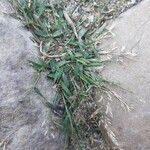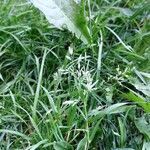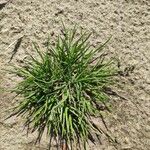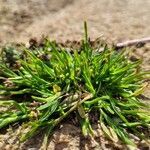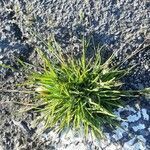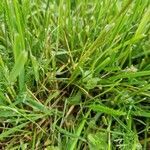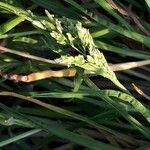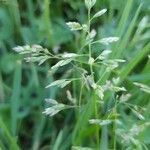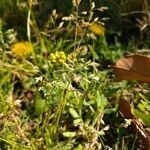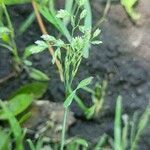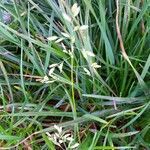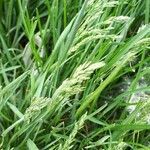Loosely to compactly tufted, usually bright green annual, to 35 cm, or short-lived perennial; branching intravaginal; leaf-blades persistent. Leaf-sheath pale green, hyaline, glabrous, keeled. Ligule 0.5-2 mm, entire, rounded, glabrous throughout. Leaf-blade 1.5-9 cm × 3-4 mm, flat or folded, soft, glabrous, often crinkled when young; margins sparsely, minutely scabrid, tip rounded to blunt point. Culm 3-20 cm, erect, spreading or prostrate, internodes glabrous. Panicle 2-10 cm, usually open, erect; branches smooth to sparsely scabrid, spreading to deflexed after anthesis. Spikelets 4-6 mm, with 3-6 crowded florets, light green or sometimes purplish. Glumes ± unequal, glabrous; lower 1.5-2.5 mm, 1-nerved, lanceolate to ovate, acute, upper 2-3 mm, 3-nerved, elliptic to oblong, subobtuse. Lemma 3-3.5 mm, 5-nerved, nerves densely hairy for about ½ length and glabrous above hairs, internerves glabrous, rarely lemma entirely glabrous, purplish just below hyaline band at obtuse tip. Palea 2.5-3 mm, keels long-ciliate, or rarely glabrous, interkeel glabrous. Callus glabrous. Rachilla 0.5-1 mm, glabrous; prolongation much shorter. Lodicules 0.3 mm. Gynomonoecious: each spikelet with 2-3 lower flowers ☿, anthers (0.6)-0.7-1 mm, gynoecium 1-1.5 mm; upper flowers ♀, pollen-sterile anthers to 0.2 mm or 0, gynoecium c. 1.5 mm. Caryopsis c. 1.5 × 0.5 mm, tightly enclosed by anthoecium.
Weakly caespitose annual (rarely perennial in benign conditions). Culms 2–30 (–50) cm high, slender, weak, rarely rooting from lower nodes; mid-culm internodes glabrous, often somewhat compressed. Young shoots intravaginal. Leaves: basal sheaths with margins connate in lower half, thin, glabrous; ligule 0.9–3.4 (–5) mm long, obtuse or truncate, thinly membranous, glabrous; blade flat or channelled, 0.5–12 cm long, 1–5 mm wide, thin-textured, glabrous or scabridulous along veins and margins of both surfaces, bright green. Panicles finally ovate or triangular with spreading branches, 1.4–8 (–10) cm long. Spikelets 4–6 mm long, with 3 or 4 (–10) bisexual florets. Glumes: lower glume (1.5–) 2–3 mm long, 1 or 3-nerved, with lateral nerves short; upper glume 2–4 mm long, 3-nerved. Web absent. Lemma (2.5–) 3–4 mm long, prominently 5-nerved; nerves usually villous in lower half; intercostal regions glabrous or puberulous. Anthers (0.5–) 0.9–1.1 (–1.3) mm long.
Loosely to compactly tufted annual, sometimes biennial, 25-300 mm high; maybe stoloniferous or rooting at nodes; culms usually geniculate at base. Leaf blade 20-50 (-140) x 1-5 mm, expanded or folded, flaccid; ligule an unfringed membrane (0.5-) 2.0-5.0 mm long. Inflorescence a ± pyramidal panicle, 10-120 mm long; branches solitary or paired, spreading horizontally or almost so at maturity; spikelets aggregated in upper 1/2 of branches. Spikelets (3-)4-6 mm long, laterally compressed, awnless; glumes ± equal, shorter than spikelet; lower glume 1-nerved; upper glume 3-nerved. Florets 3-5; lemmas entire, keeled, 5-7-nerved, membranous, densely to sparsely woolly on keel and marginal nerves below middle or glabrous; palea keels ciliate or woolly; anther 0.6-0.8(-1.0) mm long. Flowering time Dec., Jan., usually in rainy season of a particular region.
Loosely to compactly tufted annual, sometimes biennial, 25-300 mm high; sometimes stoloniferous or rooting at nodes; culms usually geniculate at base. Leaf blade 20-50(-140) x 1-5 mm, expanded or folded, flaccid; ligule (0.5)2.0-5.0 mm long; obtuse to truncate. Inflorescence ± pyramidal, 10-120 mm long; branches solitary or paired, spreading horizontally or almost so at maturity, less than own length apart; spikelets aggregated in upper 1/2 of branches. Spikelet (3)4-6 mm long; 3-5-flowered; lower glume 1-nerved; lemmas strongly overlapping, membranous, margins and apex broad, white, delicate, densely to sparsely hairy on keel and margins near base or apex, occasionally glabrous; palea keels densely hairy or glabrous; anthers 0.6-0.8(1.0) mm long.
Loosely to compactly tufted annual or short-lived perennial; culms 2.5–30 cm. high, erect, spreading or prostrate.. Leaf-blades 1–14 cm. long and 1–5 mm. wide, weak, often crinkled when young, blunt at the tip; ligule 2–5 mm. long.. Panicle ovate or triangular, 1–12 cm. long, open and loose or somewhat dense.. Spikelets 3–10-flowered, ovate or oblong, 3–10 mm. long; lower glume lanceolate to ovate, 1.5–3 mm. long, 1-nerved; upper glume elliptic or oblong, 2–4 mm. long, 3-nerved, broadest at about the middle; lemmas broadly elliptic with prominent white hyaline margins, 2.5–4 mm. long, obtuse to emarginate (obtuse in side view), glabrous or hairy on the nerves; palea-keels glabrous or ciliate; anthers 0.7–1.2(–1.6) mm. long.
Tufted annual with few–several decumbent to ascending or seldom erect culms to 3 dm, sometimes rooting at the lower nodes; sheaths loose; blades soft, 2–3 mm wide; infl ovoid, 2–8 cm, with few ascending branches bearing rather crowded spikelets above the middle; spikelets green, 3–5 mm, 3–6-fld; glumes broadly lanceolate, acute, scarious-margined, indistinctly veined, the first 1.5–2.4 mm, the second 1.8–2.8 mm; lemmas thin, elliptic, 5-veined, obtuse, ± hairy on the veins only, not webbed, the lowest one 2.4–3.4 mm; anthers 0.8–1 mm; 2n=14, 28. Native of Eurasia; abundant in moist soil nearly throughout the U.S. and n. to Lab. and Alas.; often a lawn-weed.
Soft, erect or decumbent-spreading annual; culms flattened, commonly 5-20 cm. high, glabrous; sheaths thin with hyaline margins, mostly longer than the internodes; ligule hyaline, about 5 mm. long; blades flat, mostly 5-10 cm. long, 1-3 mm. wide, the margins scabrous; panicle 3-10 cm. long, open with rather short ascending to spreading branches; spikelets short-pedicelled, crowded, 3-to 6-flowered; first glume 1.5-2 mm., the second 2-2.5 mm. long; lemmas about 3 mm. long, subobtuse, distinctly nerved, densely pubescent on the nerves, not webbed at the base.
Annual; sometimes biennial; up to 0.3 m high; loosely or compactly tufted. Leaf blades 20-50(-140) x 1-5 mm; flaccid. Flowers: panicle open; roughly pyramidal; 10-120 mm long; branches solitary or paired; spreading horizontally or almost so at maturity; spikelets 4-6 mm long; spikelets aggregated in upper half of branches; 3-5-flowered; lemma keels; margins and lateral nerves usually densely hairy; occasionally glabrous or sparsely hairy; anthers 0.6-0.8(1.0) mm long.
Annual (sometimes biennial), loosely or compactly tufted (culms usually geniculate at base), up to 300 mm tall. Leaf blades 20-50(-140) mm long, 1-5 mm wide, flaccid. Spikelets 4-6 mm long. Panicle roughly pyramidal, 10-120 mm long; branches solitary or paired, spreading horizontally or almost so at maturity; spikelets aggregated in upper half of branches, 3-5-flowered; anthers 0.6-0.8 mm long.
Soft, bright green annual, sometimes biennial, up to 300 mm tall. Leaves linear-oblong, flaccid; ligule an unfringed membrane. Inflorescence a pyramidal panicle. Spikelets 4-6 x 1.3-2.3 mm, awnless, 3-many-flowered; glumes shorter than spikelet, lower glume 1.5-3 mm long, 1-nerved; rhachilla not or only tardily breaking up; lemmas glabrous or hairy, keeled, 5-nerved.
Panicle 2-8(12) cm. long, open or more rarely contracted, ovate in outline, somewhat stiff; branches usually 2 (rarely 3-5)-nate or solitary, spreading at first, later usually slightly deflexed, smooth; pedicels 0·3-5 mm. long, smooth.
Leaf-laminae 1·5-10(15) x 0·1-0·5 cm., linear or linear-oblong, with the apex abruptly acute or often cucullate, expanded or folded, flaccid, scaberulous along the margins otherwise smooth, glabrous.
Culms 2·5-30 cm. tall, 2-4-noded, erect, spreading or decumbent, sometimes rooting at the lower nodes, rather slender, terete, glabrous, smooth.
Spikelets 3-8(10) mm. long, 3-7(10)-flowered, ovate to oblong in outline, usually crowded, green or often tinged with purple.
Inferior glume 1·5-3 mm. long, 1-nerved, ovate or lanceolate; the superior 2-4·25 mm. long, 3-nerved, elliptic or oblong.
Annual, sometimes biennial to 30 cm. Leaves linear-oblong, flaccid. Spikelets in a pyramidal panicle, anthers to 0.8 mm.
Lemmas 2·3-4·25 mm. long, broadly elliptic or ovate-elliptic with white hyaline margins, with the apex obtuse.
Leaf-sheaths usually loose, somewhat compressed, keeled, smooth, usually glabrous.
A caespitose delicate annual (very rarely perennial).
Loosely tufted annual up to about 15 cm. high.
Anthers 0·7-1·2(1·6) mm. long.
Caryopsis 1-2 mm. long.
Ligule 2-5 mm. long.
